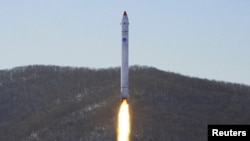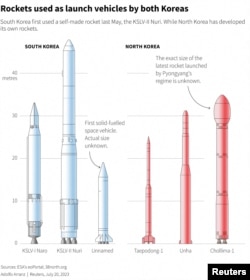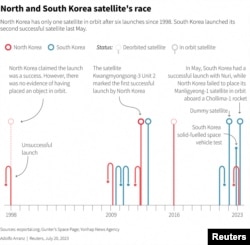It's been an eventful year for the rival space programs of Seoul and Pyongyang: on May 25, South Korea for the first time used an indigenous launch vehicle to place a mission-capable satellite in orbit, and a few days later, North Korea launched a new rocket design from a new facility.
These rockets are the result of decades of development. South Korea's Nuri launcher is its first entirely indigenous design, and Seoul has ambitions of placing military and civilian satellites in orbit.
The North has cycled through several dramatically different launchers, and its Chollima-1 booster appears more advanced than anything it has flown to date, although its maiden test in May ended in failure.
While the programs lag behind those of their neighboring Japan and China, both nations have linked rockets to national pride. North Korean leader Kim Jong Un has called space "a demonstration of the overall national power" and former South Korean President Moon Jae-in said the first launch of the Nuri rocket in 2021 heralded the approach of a "Korea Space Age."
The North's latest push suggests it is serious about deploying operational satellites, said Jonathan McDowell, an astronomer and astrophysicist at the Harvard–Smithsonian Center for Astrophysics.
"The new phase of their program is clearly moving from an experimental 'get something into orbit' phase to a phase in which operational satellites will be in play," he said. "For now, low orbit recon satellites, but eventually I expect them to launch geostationary communications satellites too."
Aiming higher
Both countries have poured resources into launch facilities.
South Korea's Naro Space Center, perched on cliffs overlooking the sea on southern Oenaro Island, opened in 2009 and has expanded in recent years.
North Korea built its first satellite launching facility at the eastern site of Tonghae in 1985. Sohae, on the west coast, was completed in 2011.
The Chollima-1 was launched from a new pad at Sohae built in just over a month, underscoring the political importance of the launch and the overall satellite program, 38 North, a U.S.-based site that monitors North Korea, said in a June 7 report.
"The speed at which North Korea built the new coastal launch pad for the Chollima-1 at Sohae is astonishing," said Markus Schiller, a Europe-based missile expert. "This indicates they have the means to do that, and impressive resources at hand."
The next flight of South Korea's Nuri is expected in 2025. It plans to use the follow-on KSLV-III project as the mainstay of its spaceflight program by 2030.
"The road from South Korea to space has opened now," President Yoon Suk Yeol said after the 2022 Nuri launch. "It's the fruit of the difficult challenges of the past 30 years. Now, our Korean people and our young people's dream and hope will reach toward space."









